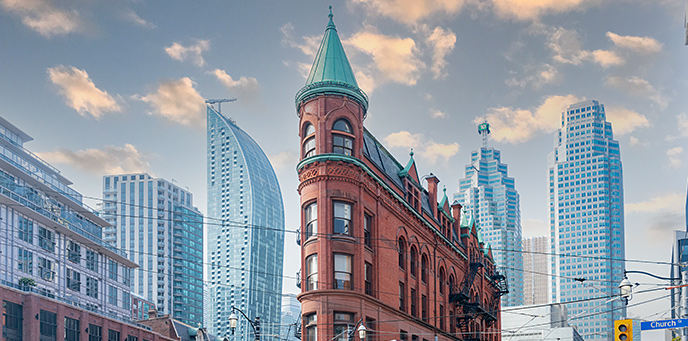Gooderham Building Entrance Fee: Information for Tourists About Costs.: How Weather and Close-by Spots Can Make It Memorable.}
Gooderham Building Entrance Fee: Information for Tourists About Costs.: How Weather and Close-by Spots Can Make It Memorable.}
Blog Article
Uncover the Rich History Behind the Gooderham Structure in Toronto
The Gooderham Building, an exemplary manifestation of Richardsonian Romanesque architecture in Toronto, has a fabled past that expands beyond its striking red brick frontage. Appointed by the influential Gooderham and Worts distillery in 1891, this building has played a pivotal role in shaping the urban landscape of the St. Lawrence Market area.

Origins of the Gooderham Building
Creating an enduring legacy, the Gooderham Structure, likewise called the Flatiron Building, became a symbol of Toronto's architectural development in the late 19th century. The structure's origins trace back to 1891 when it was commissioned by the Gooderham and Worts distillery, one of copyright's biggest distilling business. Designed by architect David Roberts Jr. Gooderham Building address., the structure was distinctively placed at the crossway of Front and Wellington Streets, making use of a triangular great deal created by the convergence of these roads
The structure's building made use of local red brick and terracotta, establishing a distinctive aesthetic that matched the expanding cityscape. Originally meant to house the Gooderham and Worts workplaces, the building stood for the success of the distillery, which had ended up being a substantial contributor to Toronto's economic climate. Especially, the conclusion of the Gooderham Building accompanied a period of rapid urbanization that defined the age.
The establishment of this building gem not only showcased innovative design but likewise laid the foundation for future growths in Toronto. Today, it stands as a testament to the city's rich history and adaptability, remaining to attract visitors and admirers from around the globe.
Architectural Value
The architectural significance of the Gooderham Building extends past its distinct flatiron shape, reflecting the ingenious spirit of late 19th-century layout. Finished in 1892, the framework exemplifies the Richardsonian Romanesque style, characterized by its durable stonework, rounded arcs, and detailed outlining. The vibrant use of contrasting products, specifically the warm red brick and limestone accents, enhances its aesthetic charm and demonstrates the craftsmanship of the period.
The structure's three-story style is noteworthy for its harmonious percentages and sophisticated cornice, which contribute to its famous shape versus the Toronto horizon. The narrow whole lot on which it stands presented unique challenges, yet the architects, in this situation, developed a structure that made the most of the available space while keeping aesthetic balance.
In Addition, the Gooderham Building is a testimony to the versatility of architectural style in urban atmospheres. Its long-lasting existence in the middle of modern advancements highlights the worth of preserving historic style as a way of honoring a city's past. Today, it continues to be a precious spots, showing both the architectural fads of its time and the progressing narrative of Toronto as a vivid metropolitan center.
Duty in Toronto's Advancement
Emerging as a principal in Toronto's urban landscape, the Gooderham Structure contributed significantly to the city's growth during the late 19th century. Created in 1892, this renowned erection stood for not only the building passions of the moment but additionally the blossoming economic landscape of Toronto. The building was originally designed to serve as a warehouse for the Gooderham and Worts distillery, which was among the biggest distilleries in the British Realm. Its tactical place at the junction of Front and Wellington Streets promoted the movement of products and solutions, highlighting the area's significance in the city's business activities.
As the city expanded, the Gooderham Structure came to be an important element of the St. Lawrence Market location, which was a center of trade and business. Its special building design and prominent presence drew interest, affecting the layout of succeeding structures in the location. The structure's survival with various economic shifts and metropolitan advancements shows the durability and versatility of Toronto's historic landscape. Basically, the Gooderham Building is not simply an architectural landmark; it played a pivotal duty in shaping Toronto's identity and financial development throughout a transformative duration in its background.
Social Effect and Legacy
Gooderham Structure's unique building style and historic value have left an enduring mark on Toronto's social landscape. As one of the city's most recognizable landmarks, its unique flatiron form and complex brickwork exemplify the Victorian building patterns of the late 19th century. This structure not only serves as a visual support in the St. Lawrence community but also personifies the spirit of an expanding city during an age of economic development.
The structure my response has actually ended up being a sign of Toronto's abundant history, inspiring neighborhood artists and photographers that seek to record its appeal. Its existence has promoted a feeling of neighborhood identification, contributing to the narrative of metropolitan advancement. The Gooderham Building has actually played a critical duty in the tourist sector, drawing in visitors excited to explore its fabled past and building charm.
Along with its aesthetic charm, the structure envelops a story of resilience and adaptation, as it has transitioned with numerous uses over the decades - Gooderham Building address. Therefore, the Gooderham Building stands not just as a monolith of architectural significance but likewise as a testimony to the evolving cultural heritage of Toronto

Reconstruction and Preservation Efforts
Numerous reconstruction and conservation efforts have been undertaken to ensure the Gooderham Structure stays an important part of Toronto's architectural heritage. Initially completed in 1892, the building has actually gone through significant improvements to resolve structural issues while retaining its historic integrity. One of the most significant remediation took place in the late 20th century when the building was carefully refurbished to satisfy modern safety criteria without endangering its initial design elements.
These initiatives included fixing the unique red-brick frontage, bring back the iconic triangular form, and protecting the intricate stonework details. Furthermore, the structure's interior has actually seen careful updates that appreciate its historic importance, making certain that original functions such as wood beams and attractive moldings are maintained.
The Gooderham Building is now shielded as a designated heritage property under the Ontario Heritage Act, which assists guard it from inappropriate modifications. Area engagement has actually played an important duty in these conservation initiatives, with neighborhood advocacy teams elevating recognition about the structure's historic importance. As a result, the Gooderham Building stands not only as a useful room however also as a testament to Toronto's rich building background and enduring social heritage.
Verdict

Please visit one of our local supporters - Gamerama And The Repair Store - Toronto Iphone Repair
Report this page